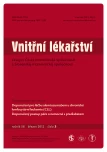Castleman’s disease
Authors:
D. Majerčáková
Authors‘ workplace:
Lékařská fakulta MU Brno, děkan prof. MUDr. Jiří Mayer, CSc.
Published in:
Vnitř Lék 2012; 58(3): 216-220
Category:
Reviews
Overview
Castleman’s disease is a rare but potentially serious diagnosis and, therefore, this paper aims to enhance the medical community’s knowledge of this diverse disease. This is a non-malignant angiofollicular nodular hyperplasia. There are three types according to the histological picture – hyalinvascular, plasmocellular and plasmablastic, and two types according to the clinical picture – unicentric and multicentric. The symptoms are rather heterogeneous, from an asymptomatic mass seen in the unicentric form, to life-threatening systemic inflammatory state with systemic symptoms in the multicentric form. Pathophysiological mechanism involves hypersecretion of IL-6 cytokin, although the process trigger is known only in a small proportion of cases. This is HHV-8 infection that, however, is not found in every patient with Castleman’s disease. Aetiology in HHV-8 negative patients is unclear. The disease is associated with a range of autoimmune conditions and some haematological malignancies. Surgical resection, sometimes followed with radiotherapy, is the gold standard in the treatment of the unicentric form. Anti-IL-6 monoclonal antibodies are the optimal therapy of the multicentric form, although other modalities, including corticosteroids, chemotherapy (CHOP, CVAD), immunomodulators and rituximab, given in monotherapy or in combination, are more accessible in real practice.
Key words:
Castleman’s disease – corticosteroids – chemotherapy – rituximab – thalidomide – tocilizumab
Sources
1. Castleman B, Towne VW. Case records of the Massachusetts General Hospital: Case No. 40231. N Engl J Med 1954; 250: 1001–1005.
2. Castleman B, Iverson L, Menendez VP. Localized mediastinal lymph-node hyperplasia resembling thymoma. Cancer 1956; 9: 822–830.
3. Keller AR, Hochholzer L, Castleman B. Hyaline-vascular and plasma-cell types of giant lymph node hyperplasia of the mediastinum and other locations. Cancer 1972; 29: 670–683.
4. Cronin DMP, Warnke RA. Castleman Disease: An Update on Classification and the Spectrum of Associated Lesions. Adv Anat Pathol 2009; 16: 236–246.
5. Menke DM, Tiemann M, Camoriano JK et al. Diagnosis of Castleman’s disease by identification of an immunophenotypically aberrant population of mantle zone B lymphocytes in paraffin-embedded lymph node biopsies. Am J Clin Pathol 1996; 105: 268–276.
6. Van Rhee F, Stone K, Szmania S et al. Castleman Disease in the 21st Century: An Update on Diagnosis, Assessment, and Therapy. Clin Adv Hematol Oncol 2010; 8: 486–498.
7. Casper C. The aetiology and management of Castleman disease at 50 years: translating pathophysiology to patient care. Br J Haematol 2005; 129: 3–17.
8. Brandt SJ, Bodine DM, Dunbar CE et al. Dysregulated interleukin 6 expression produces a syndrome resembling Castleman’s disease in mice. J Clin Invest 1990; 86: 592–599.
9. Katsume A, Saito H, Yamada Y et al. Anti-interleukin 6 (IL-6) receptor antibody suppresses Castleman’s disease like symptoms emerged in IL-6 transgenic mice. Cytokine 2002; 20: 304–311.
10. Dispenzieri A, Gertz MA. Treatment of Castleman’s Disease. Curr Tret Options Oncol 2005; 6: 255–266.
11. Tsukamoto Y, Hanada N, Nomura Y et al. Rapidly progressive renal failure associated with angiofollicular lymph node hyperplasia. Am J Nephrol 1991; 11: 430–436.
12. Zhao X, Shi R, Jin X et al. Diffuse hyperpigmented plaques as cutaneous manifestation of multicentric Castleman disease and treatment with thalidomide: Report of three cases. J Am Acad Dermatol 2011; 65: 430–432.
13. Rieu P, Droz D, Gessain A et al. Retinoic acid for treatment of multicentric Castleman’s disease. Lancet 1999; 354: 1262–1263.
14. Hess G, Wagner V, Kreft A et al. Effects of bortezomib on pro-inflammatory cytokine levels and transfusion dependency in a patient with multicentric Castleman Disease. Br J Haematol 2006; 134: 544–549.
15. Sato K, Tsuchiya M, Saldanha J et al. Reshaping a Human Antibody to Inhibit the Interleukin-dependent Tumor Cell Growth. Cancer Res 1993; 53: 851–856.
16. Nishimoto N, Kanakura Y, Aozasa K et al. Humanized anti-interleukin-6 receptor antibody treatment of multicentric Castleman disease. Blood 2005; 106: 2627–2632.
Labels
Diabetology Endocrinology Internal medicineArticle was published in
Internal Medicine

2012 Issue 3
Most read in this issue
- Castleman’s disease
- The role of PET-CT in decision making on the treatment of localized nodular form of pulmonary AL-amyloidosis
- FTO gene and his role in genetic determination of obesity
- Blood pressure changes in chronically haemodialysed patients
